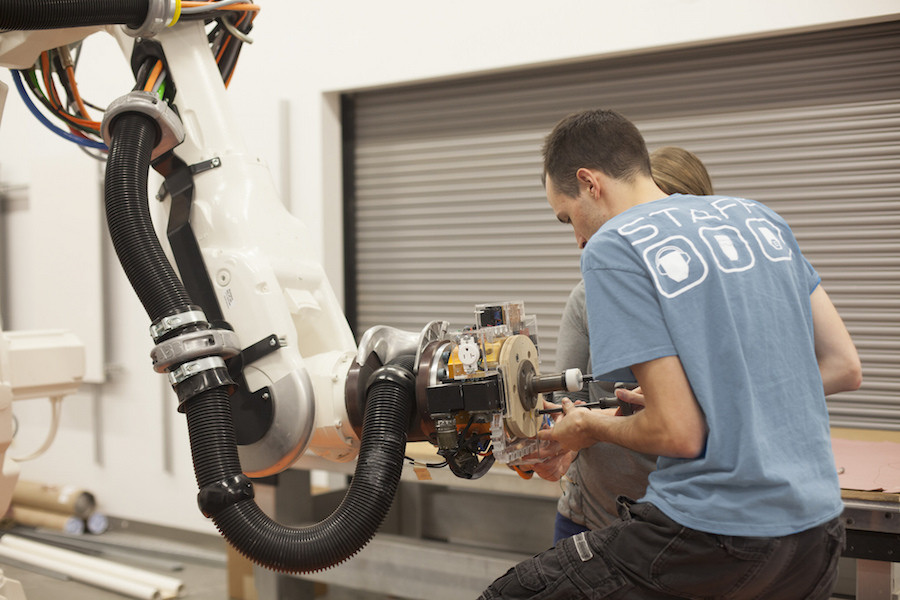In recent work, we begin to remedy this problem (Graetz and Michaels 2015). We compile a new dataset spanning 14 industries (mainly manufacturing, but also agriculture and utilities) in 17 developed countries (including the European nations, Australia, South Korea, and the US). Uniquely, our dataset includes a measure of the use of industrial robots employed in each industry, in these countries, and how it has changed from 1993-2007. We obtain information on other economic performance indicators from the EUKLEMS database (Timmer et al. 2007).
We find that industrial robots increase labour productivity, total factor productivity and wages. At the same time, while industrial robots had no significant effect on total hours worked, there is some evidence that they reduced the employment of low skilled workers, and, to a lesser extent, middle skilled workers.
A first glance
What exactly are industrial robots? Our data comes from the International Federation of Robotics (IFR). The IFR considers a machine to be an industrial robot if it can be programmed to perform physical, production-related tasks without the need for a human controller. (The technical definition refers to a “manipulating industrial robot as defined by ISO 8373: An automatically controlled, reprogrammable, multipurpose manipulator programmable in three or more axes, which may be either fixed in place or mobile, for use in industrial automation applications”).
Industrial robots dramatically increase the scope for replacing human labour, compared to older types of machines, since they reduce the need for human intervention in automated processes. Typical applications for industrial robots include assembling, dispensing, handling, processing (cutting, for instance) and welding – all of which are prevalent in manufacturing industries – as well as harvesting (in agriculture) and inspection of equipment and structures (common in power plants).
Rapid technological change reduced the price of industrial robots (adjusted for changes in quality) by around 80 percent during our sample period. Unsurprisingly, robot use grew dramatically: from 1993-2007, the ratio of the number of robots to hours worked increased, on average, by about 150 percent. The rise in robot use was particularly pronounced in Germany, Denmark, and Italy and among producers of transportation equipment, chemical and metal industries.
To estimate the impact of robots, we take advantage of variation across industries and countries and over time. We check the robustness of our results by including a large number of controls, and by considering alternative ways of measuring the robot input. A consistent picture emerges in which robots appear to raise productivity, without causing total hours to decline.
Addressing reverse causality
Could it be that higher productivity causes a larger increase in robot use, rather than the other way around? To address this and related concerns, and to shed further light on the causal effect of robots, we develop a novel instrumental variable strategy. Our instrument for increased robot use is a measure of workers’ replaceability by robots, based on the tasks prevalent in industries before robots were widely employed. Specifically, we match data on tasks performed by industrial robots today with data on similar tasks performed by US workers in 1980, before robots were used. We then compute the fraction of each industry’s working hours in 1980 accounted for by occupations that subsequently became prone to replacement. Our industry-level ‘replaceability’ index strongly predicts increased robot use from 1993-2007.
When we use our instrument to capture differences in the increased use of robots, we again find that robots increased productivity, and detect no significant effect on hours worked. As an important check on the validity of this exercise, we find no significant relationship between replaceability and productivity growth in the period before the adoption of robots.
We conservatively calculate that, on average, the increased use of robots contributed about 0.37 percentage points to the annual GDP growth, accounting for more than one tenth of total GDP growth over this period. The contribution to labour productivity growth was about 0.36 percentage points, accounting for one sixth of productivity growth. This makes the contribution of robots to the aggregate economy roughly on par with previous important technologies, such as railroads in the nineteenth century (Crafts 2004) and US highways in the twentieth century (Fernald 1999). The effects are also fairly comparable to the recent contributions of information and communication technologies (ICT, see e.g. O’Mahoney and Timmer 2009). But it is worth noting that robots make up just over two percent of capital, which is much less than previous technological drivers of growth.
Discussion and conclusion
Our findings on the aggregate impact of robots are interesting given recent concerns in the macroeconomic literature that productivity gains from technology, in general, may have slowed down. Gordon (2012, 2014) expresses a particularly pessimistic view, and there are wider concerns about secular macroeconomic stagnation (Summers 2014, Krugman 2014), although others remain more optimistic (Brynjolfsson and McAfee 2014). We expect that the beneficial effects of robots will extend into the future, as new robot capabilities are developed and service robots come of age. Our findings do come with a note of caution: there is some evidence of diminishing marginal returns, or congestion effects, to robot use, so they are not a panacea for growth.
Although we do not find evidence of a negative impact of robots on aggregate employment, we see a more nuanced picture when we break jobs and the wage cost down by skill groups. Robots appear to reduce the hours and the wage costs of low-skilled workers, and to a lesser extent middle skilled workers. They have no significant effect on the employment of high-skilled workers. This pattern differs from the effect that recent work has found for ICT, which seems to benefit high-skilled workers at the expense of middle-skilled workers (Autor 2014, Michaels et al. 2014).
In further results, we find that industrial robots increased total factor productivity and wages. At the same time, we find no significant effect of robots on the labour share.
In summary, we find that industrial robots made significant contributions to labour productivity and aggregate growth, and also increased wages and total factor productivity. While fears that robots destroy jobs on a large scale have not materialised, we find some evidence that robots reduced low and middle-skilled workers’ employment.
Preliminary post-2007 data show the number of robots has continued to swell, and the set of tasks they can perform has expanded. Both of these trends indicate that robots will continue to play an important role in improving productivity.






